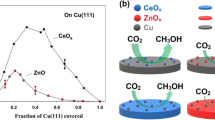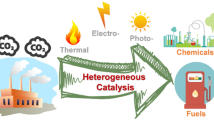Abstract
In this paper, an efficient and green CuMgA catalyst was prepared with the co-precipitation method. The geometric structure and electronic properties of the catalyst was analyzed by X-ray powder diffraction (XRD), transmission electron microscopy (TEM), X-ray photoelectron spectroscopy (XPS), hydrogen temperature-programmed reduction (H2-TPR) and Fourier infrared spectroscopy (FI-IR). It was found that Cu nanoparticles in the catalyst had uniform dispersion with a suitable Cu0 to Cu+ ratio. Also, the calcination temperature had a significant effect on the composition and structure of the Cu-based catalyst, and the prepared CuMgAl catalyst could be calcinated at 723 K to obtain particles with small size and highly dispersed Cu+ and Cu0 species. In addition, Catalytic hydrogenation of dimethyl 1,4-cyclohexane dicarboxylate (DMCD) was carried out with a high-pressure reactor using a CuMgAl catalyst. Surprisingly, under mild conditions with an initial hydrogen pressure of 2.8 Mpa, the conversion of DMCD was up to 100%, and the product selectivity of 1,4-cyclohexane dimethanol can reach 91.6%, which meaning important guiding significance for further industrial applications to achieve a more efficient and environmentally friendly production process.
Graphical Abstract





Similar content being viewed by others
References
Sepehri S, Rafizadeh M (2009) Synthesis and characterization of copolymers of poly (ethylene terephthalate) and cyclohexane dimethanol in a semibatch reactor (including the process model). J Appl Polym Sci 113(6):3520–3532
Turner SR, King B (2005) Amorphous copolyesters containing monomers derived from bisphenols. High Perform Polym 17(3):361–376
Luo J, Qu E (2020) Re/AC catalysts for selective hydrogenation of dimethyl 1, 4-cyclohexanedicarboxylate to 1, 4-cyclohexanedimethanol: essential roles of metal dispersion and chemical environment. Appl Catal A 602:117669
Zhang S, Hu Q (2013) The relationship between the structure and catalytic performance Cu/ZnO/ZrO2 catalysts for hydrogenation of dimethyl 1,4-cyclohexane dicarboxylate. Catal Commun 39:96–101
Xiaoxiao G, Meiling W (2017) Copper nanoparticles socketed in situ into copper phyllosilicate nanotubes with enhanced performance for chemoselective hydrogenation of esters. Chem Commun (Camb) 53(51):6933–6936
Hu Q, Fan G (2015) Gas phase hydrogenation of dimethyl-1,4-cyclohexane dicarboxylate over highly dispersed and stable supported copper-based catalysts. J Mol Catal A 397:134–141
Xiao X, Xin H (2022) One-pot conversion of dimethyl terephthalate to 1,4-cyclohexanedimethanol. Appl Catal A 632:118510
Hanwen Liu HuQ (2015) Surface synergistic effect in well-dispersed Cu/MgO catalysts for highly efficient vapor-phase hydrogenation of carbonyl compounds. Catal Sci Technol 5(8):3960–3669
Shaoyan Z, Fan G (2013) Lewis-base-promoted copper-based catalyst for highly efficient hydrogenation of dimethyl 1,4-cyclohexane dicarboxylate. Green Chem 15(9):2389
Gérardin C, Kostadinova D (2008) LDH nanocomposites with different guest entities as precursors of supported Ni catalysts. Chem Mater 20(6):2086–2094
Chatterjee A, Bharadiya P (2019) Layered double hydroxide based bionanocomposites. Appl Clay Sci 177:19–36
Hu CW, Li DF (2001) Supermolecular layered double hydroxides. Chin Sci Bull 46(13):1061–1066
Jamil S, Alvi AR (2019) Layered double hydroxides (LDHs): synthesis & applications. Prog Chem 31(2–3):394–412
Basąg S, Piwowarska Z (2016) Cu-Mg-Al hydrotalcite-like materials as precursors of effective catalysts for selective oxidation of ammonia to dinitrogen—the influence of Mg/Al ratio and calcination temperature. Appl Clay Sci 129:122–130
Yuan P, Liu Z (2010) Cu-Zn/Al2O3 catalyst for the hydrogenation of esters to alcohols. Chin J Catal 31(7):769–775
Bharali D, Deka RC (2017) Preferential adsorption of various anionic and cationic dyes from aqueous solution over ternary CuMgAl layered double hydroxide. Colloids Surf A 525:64–76
Comelli NA, Ruiz ML (2018) Influence of the synthetic conditions on the composition, morphology of CuMgAl hydrotalcites and their use as catalytic precursor in diesel soot combustion reactions. Appl Clay Sci 157:148–157
Jiao S, Guo-qing R (2017) Effect of calcination temperature on the catalytic performance of CuMgAl catalysts for furfural gas phase selective hydrogenation to furfuryl alcohol. J Fuel Chem Technol 45(1):43–47
Gonçalves RGL, Lopes PA (2019) Performance of magnetite/layered double hydroxide composite for dye removal via adsorption, fenton and photo-fenton processes. Appl Clay Sci 179:105152
Ma X, Liu T (2023) Preparation and performance of Cd-MgAl-LDHs@RGO in high efficiency electrocatalytic reduction of CO2 to CO. Mol Catal 535:112876
Acknowledgements
This research was supported by the National Natural Science Foundation of China (22378047), the National Key Research and Development Program of China (2019YFC1803804-03), Research and Innovation Team Project of Dalian University of Technology (DUT2022TB10).
Funding
The study was funded by The Natural Science Foundation of Liaoning Province, 2020-MS-117, Research and Innovation Team Project of Dalian University of Technology, DUT2022TB10, and the Fundamental Research Funds National Key Research and Development Program of China, 2019YFC1803804-03.
Author information
Authors and Affiliations
Corresponding author
Additional information
Publisher's Note
Springer Nature remains neutral with regard to jurisdictional claims in published maps and institutional affiliations.
Supplementary Information
Below is the link to the electronic supplementary material.
Rights and permissions
Springer Nature or its licensor (e.g. a society or other partner) holds exclusive rights to this article under a publishing agreement with the author(s) or other rightsholder(s); author self-archiving of the accepted manuscript version of this article is solely governed by the terms of such publishing agreement and applicable law.
About this article
Cite this article
Yang, Z., Ren, X., Zhang, H. et al. CuMgAl Catalyzed Dimethyl 1,4-cyclohexane dicarboxylate to 1,4-Cyclohexane dimethanol Under Relatively Mild Conditions. Catal Lett (2024). https://doi.org/10.1007/s10562-024-04632-y
Received:
Accepted:
Published:
DOI: https://doi.org/10.1007/s10562-024-04632-y




